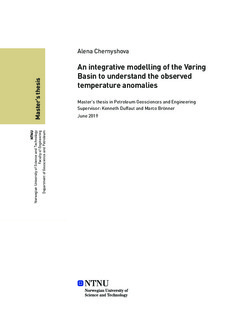| dc.contributor.advisor | Duffaut, Kenneth | |
| dc.contributor.advisor | Brönner, Marco | |
| dc.contributor.author | Chernyshova, Alena | |
| dc.date.accessioned | 2019-09-27T14:00:27Z | |
| dc.date.available | 2019-09-27T14:00:27Z | |
| dc.date.issued | 2019 | |
| dc.identifier.uri | http://hdl.handle.net/11250/2619197 | |
| dc.description.abstract | Letebrønner i Vøringbassenget avslører svært varierende termisk profil. Høye temperatur- og varmestrømavvik er oppdaget på Gjallarryggen, Grønøyhøyden og i Vestfjordenbassenget, mens observerte temperaturer på Utgardhøyden er betydelig lavere. Termisk modellering basert på brønnloggdataene viser at anomalier ikke kan forklares med Net-to-Gross variasjoner i sedimentene, og at kilden til anomaliene ligger i de dypere delene av litosfæren.
Gravimetrisk og magnetisk modellering avgrenset med seismisk tolkning, tetthets- og hastighetsstudier og seismografiske hastighetsprofiler hjelper til å definere skorpestrukturen i Vøringbassenget. Skorpe er delt inn i øvre, midtre og nedre deler i tillegg til et høyhastighets nedre legeme lokalisert ved den vestlige delen av bassenget. Den lavmagnetiske øvre skorpen tolkes som Kaledonske metasedimeter og felsiske metamorfe bergarter. Den midterste skorpen består imidlertid av høy-grad metamorfe granittiske bergarter av Prekambrisk alder. Den nederste skorpen er tolket som høy grad eldre mafiske og ultramafiske bergarter, med betydelig eklogittinnhold i den siste. Korrelering av disse skorpedelene med bergarter som finnes på land, hjelper med å definere termiske parametre og lage en termisk modell av de dype lagene. Resulterende temperatur- og varmestrømsprofiler indikerer at komposisjonelle variasjoner i skorpen kan ikke forklare de termiske anomaliene. Likevel kan denne teorien bestrides dersom den øvre og midtre skorpen inneholder store mengder av granittiske bergarter med eksepsjonelle radioaktive egenskaper. Denne studien konkluderer likevel med at temperatur- og varmestrømsprofilene over Vøringbassenget vil være relatert til posisjonen til grensen mellom litosfæren og astenosfæren og en mulig mantelanomali under Lofoten-Vestfjørden-segmentet observert fra S-bølge gangtid tomografi. | |
| dc.description.abstract | Exploration wells in the Vøring Basin reveal highly varying thermal profile. High temperature and heat flow anomalies are detected at the Gjallar Ridge, on the Grønøy High and in the southern Vestfjorden Basin, while the observed temperatures at the Utgard High are significantly lower. Thermal modelling based on the well log data shows that the anomalies can not be explained by the Net-to-Gross variations within the sedimentary cover and the source of the anomalies lies in the deeper parts of the lithosphere.
Potential field modelling constrained by seismic interpretation, density and velocity studies and ocean bottom seismograph velocity profiles helps to define the crustal structure of the Vøring Basin which is divided into upper, middle and lower crust in addition to high velocity lower crustal body located at the western part of the basin. The low magnetic upper crust is interpreted to be the Caledonian metasediments and metamorphic rock of felsic composition. The middle crust, however, most likely is constituted of high grade metamorphic granitoid rocks of Precambrian age. The lower crust and the lower crustal body are interpreted as high grade older mafic to ultramafic rocks, with numerous igneous intrusions and significant eclogite content in the last one. Correlating these crustal units with the rocks discovered onshore helps to define reasonable thermal parameters and perform the thermal modelling of the deeper layers. Resulting temperature and heat flow profiles indicate that compositional variations across the basement and the lower crust can not explain the thermal deviations. However, this opinion can be debated if the upper and middle crust is proven to contain large amounts of granitoid rocks with exceptional radioactive properties. Nevertheless, the current study leads to the conclusion that temperature and heat flow trends across the Vøring Basin are likely to be related to the LAB position and a possible mantle anomaly below the Lofoten-Vestfjørden segment observed from S-wave traveltime tomography. | |
| dc.language | eng | |
| dc.publisher | NTNU | |
| dc.title | An integrative modelling of the Vøring Basin to understand the observed temperature anomalies | |
| dc.type | Master thesis | |
